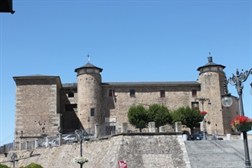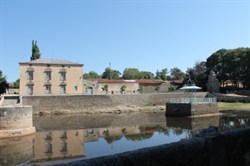The power of the Dukes of Béjar in their properties: the fortress and holiday residence
 The habitual residence of the Dukes of Béjar was the castle or fortress of Béjar, which was part of the defensive system of the villa between the twelfth and thirteenth centuries (image 1). The fortress was situated on one side of the centre of Béjar, in the upper part, in a strategic place from which the whole territory could be controlled. Typically medieval in shape, it underwent significant additions during the Renaissance and Baroque periods, although the current use of the building – which is now home to a school – has altered the original appearance. After having belonged to several noble families, connected, in various ways, to the royal family, in 1396 it became part of the possessions of the Navarrese nobleman Diego López de EstúñigaDiego López de Estúñiga (1350-1417) was a Navarrese nobleman and one of the most famous members of the House of Zúñiga. Due to his proximity to the King of Castile he was able to become justicia mayor and alguacil mayor of the kingdom, as well as regent during the minority of monarchs Enrique III and Juan II. He became Lord of Béjar in the year 1396, when he managed to receive it in exchange for the town of Frías with the favour of Enrique III. (1396-1417), the founder of the House of Béjar.
The habitual residence of the Dukes of Béjar was the castle or fortress of Béjar, which was part of the defensive system of the villa between the twelfth and thirteenth centuries (image 1). The fortress was situated on one side of the centre of Béjar, in the upper part, in a strategic place from which the whole territory could be controlled. Typically medieval in shape, it underwent significant additions during the Renaissance and Baroque periods, although the current use of the building – which is now home to a school – has altered the original appearance. After having belonged to several noble families, connected, in various ways, to the royal family, in 1396 it became part of the possessions of the Navarrese nobleman Diego López de EstúñigaDiego López de Estúñiga (1350-1417) was a Navarrese nobleman and one of the most famous members of the House of Zúñiga. Due to his proximity to the King of Castile he was able to become justicia mayor and alguacil mayor of the kingdom, as well as regent during the minority of monarchs Enrique III and Juan II. He became Lord of Béjar in the year 1396, when he managed to receive it in exchange for the town of Frías with the favour of Enrique III. (1396-1417), the founder of the House of Béjar.
 Little by little, the fortress was adapted to the structure of a new building, on the order of the various Dukes of Béjar, losing part of its defense system and being enriched both by walls in the style of an Italian palace (image 2), and with outdoor spaces with gardens and orchards. The Renaissance and Baroque additions and changes were due to Duke Francisco de Zúñiga y Sotomayor (1523-1591), who is credited with the creation of El Bosque. It was he who built the arcaded courtyard of the interior, reminiscent of Italian gardens, and with opening a loggia of three arches on the north façade. The façade followed in a straight line and was connected visually with the villa residence of the dukes, El Bosque, located several kilometres away. During the Baroque period, the dukes, followed by the whole retinue, passed through this long road on their wagons, escorted by their personal guards until arriving at El Bosque.
Little by little, the fortress was adapted to the structure of a new building, on the order of the various Dukes of Béjar, losing part of its defense system and being enriched both by walls in the style of an Italian palace (image 2), and with outdoor spaces with gardens and orchards. The Renaissance and Baroque additions and changes were due to Duke Francisco de Zúñiga y Sotomayor (1523-1591), who is credited with the creation of El Bosque. It was he who built the arcaded courtyard of the interior, reminiscent of Italian gardens, and with opening a loggia of three arches on the north façade. The façade followed in a straight line and was connected visually with the villa residence of the dukes, El Bosque, located several kilometres away. During the Baroque period, the dukes, followed by the whole retinue, passed through this long road on their wagons, escorted by their personal guards until arriving at El Bosque.
 Upon arriving at El Bosque, one is faced with a series of buildings that showed the power of the dukes. This is the case of the building in the main terrace in front of the lake, a two-storey building that is reminiscent of Italian palaces and whose windows show the arms of each family. Next to the palace are the stables (picture 3). Behind the building, there was the ducal chapel, where the seventeenth century Baroque image of the Cristo de la Expiración stood out. Finally, separate from the palace, there was the home of the bosquero, the member of staff in charge of taking care of El Bosque‘s residence and garden.
Upon arriving at El Bosque, one is faced with a series of buildings that showed the power of the dukes. This is the case of the building in the main terrace in front of the lake, a two-storey building that is reminiscent of Italian palaces and whose windows show the arms of each family. Next to the palace are the stables (picture 3). Behind the building, there was the ducal chapel, where the seventeenth century Baroque image of the Cristo de la Expiración stood out. Finally, separate from the palace, there was the home of the bosquero, the member of staff in charge of taking care of El Bosque‘s residence and garden.
